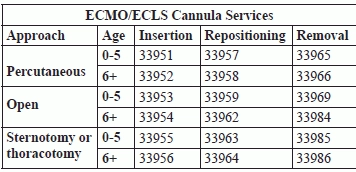Update Your ECMO/ECLS Coding With New Percutaneous Cannula Service Codes and More
Watch out for bundles that apply to the individual AND the team.
Extracorporeal membrane oxygenation (ECMO)/extracorporeal life support (ECLS) coding got a complete overhaul in CPT® 2015, offering specific codes for individual services such as percutaneous cannula insertion.
This ECMO/ECLS primer will help ensure you get the proper codes on your claim.
See the Benefits of Getting More Specific Codes
The typical ECMO/ECLS patient used to be a premature newborn, but now ECMO/ECLS providers often treat adults with severe flu, pneumonia, or respiratory distress syndrome, according to the CPT® and RBRVS 2015 Annual Symposium presentation on Cardiothoracic Surgery by Peter K. Smith, MD, of the Society of Thoracic Surgery.
Old way: For ECMO/ECLS, you used to use 33960 (Prolonged extracorporeal circulation for cardiopulmonary insufficiency; initial day) and 33961 (… each subsequent day). CPT® 2015 deleted these codes.
New way: The AMA introduced more than two dozen new codes for 2015 to make it easier to report and get paid properly for the various services involved in ECMO/ECLS. Multiple providers often participate in treatment of ECMO/ECLS patients, so having codes for individual services helps each provider report her own services.
Verify Veno-Venous and Veno-Arterial for Initiation and Management
ECMO and ECLS provide support to the heart, lungs, or both. Depending on patient needs, the physician may choose veno-arterial or veno-venous ECMO/ECLS.
In veno-arterial ECMO/ECLS, the physician places one cannula, which is a thin tube, in a large vein and places one cannula in a large artery. This method can support both the heart and lungs.
For lung support only, the physician may choose veno-venous ECMO/ECLS. This method may involve one or two cannulae in the venous system.
Identifying the type, veno-venous or veno-arterial, is crucial to code choice for initiation and daily management services.
Initiation: Initiation involves deciding which device components are correct for the patient, as well as the blood flow, gas exchange, and those sorts of necessary parameters. The physician performing this service chooses between these codes:
Daily management: For daily ECMO/ECLS management, the physician oversees the patient’s care to manage blood flow and gas exchange. He checks for clotting and bleeding issues, ensures the cannula or cannulae are in proper position, and ensures the machines are functioning properly. The codes again differ based on veno-venous (33948) and veno-arterial (33949).
Note that daily overall management of the patient is a distinct service that the performing provider may report using an E/M code. Examples listed in Smith’s presentation include hospital observation, hospital inpatient services, or critical care.
Base Surgical Services on Approach and Age
CPT® now has specific codes for cannula insertion, repositioning, and removal.
Cannula insertion coding varies by age and method.
For patients from birth to 5 years, choose from the following codes based on whether the approach is percutaneous, open, or by sternotomy/thoracotomy:
For 6 years and older, choose from:
The coding structure for cannula repositioning and removal is similar to insertion with age and approach being key features, as shown in the table below.
Other open surgical codes: If you code for open procedures, you also should be aware of +33987 (Arterial exposure with creation of graft conduit [e.g., chimney graft] to facilitate arterial perfusion for ECMO/ECLS [List separately in addition to code for primary procedure]), which you may use with open insertion codes 33953-33954 and sternotomy/thoracotomy insertion codes 33955-33956.
Also note left heart vent codes 33988 (Insertion of left heart vent by thoracic incision [e.g., sternotomy, thoracotomy] for ECMO/ECLS) and 33989 (Removal of left heart vent by thoracic incision [e.g., sternotomy, thoracotomy] for ECMO/ECLS). The vent helps keep the heart chamber from distending.
Safeguard Your Claims’ Accuracy With These Rules
To apply the cannula service codes in real world situations, you need to understand a few rules.
Repositioning rules: Initiation includes daily management and repositioning. This rule applies even when different physicians provide the services. For instance, if your physician performs repositioning on the same date another provider bills initiation for the same patient, it would be incorrect for you to report repositioning, according to CPT® guidelines.
Also, you may not report cannula repositioning at the same session as insertion.
Finally, you should not report fluoroscopic guidance separately because the codes for cannula repositioning include related fluoro.
Insertion plus: A single physician may report insertion, initiation, and an E/M code for overall management on the same date.
Removal/insertion: To report cannula replacement (removal and then insertion in the same vessel), use the insertion code.
If the physician removes a cannula from one vessel and puts a new cannula in a different vessel, report both removal and insertion codes.




